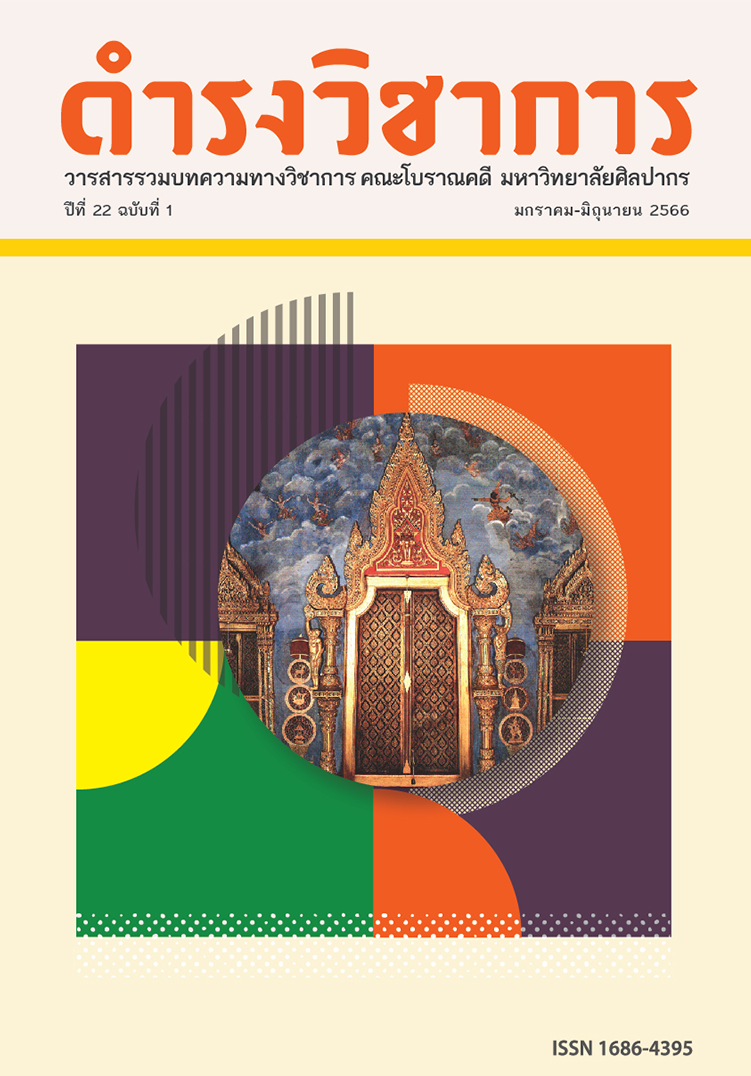Trade Relations between Patani and Japan during the Sixteenth-Eighteenth Centuries: Studying Through Ceramics
Keywords:
Japanese Porcelain, Trade between Patani and JapanAbstract
Since international commerce in Southeast Asia started in the late fifteenth century, the expansion of trade had led to the development of many ports in the Malay Peninsula and the archipelago. Patani was a port that occurred during this period. Its significance as an entrepot was based on the fact that it had all the products the market required. International traders came to this hub to conduct their business here, and one of the main trading partners for Patani was Japan. Many records make it clear that these two countries had a commercial relationship. However, we see further evidence in archaeological artifacts, especially the various types of ceramics indicating this relationship. The objective of this paper is to analyze this archaeological evidence along with historic documents to establish the timeline of trade relations between Patani and Japan during the 16-18th centuries. The results of the study have shown that Chinese merchants brought Japanese wares to Patani from the middle of the 17th century to the early 18th century and Chinese residents of Patani were the primary buyers of Japanese wares.
References
ภาษาไทย
กรมศิลปากร, 2522. บันทึกเรื่องสัมพันธภาพระหว่างกรุงสยามกับนานาประเทศในคริสต์ศตวรรษที่ 17 เล่ม 3. กรุงเทพฯ: ห้างหุ้นส่วนสหประชาพาณิชย์.
_______, 2540. เครื่องถ้วยญี่ปุ่น. กรุงเทพฯ: กรมศิลปากร.
ทวี ธีระวงศ์เสรี, 2523. “การติดต่อสัมพันธ์ระหว่างเมืองปัตตานีกับญี่ปุ่นในสมัยกรุงศรีอยุธยา.” วารสารประวัติศาสตร์ 5 (1): 1-7.
ปิยชาติ สึงตี, 2550. “การศึกษาเปรียบเทียบบทบาทของเมืองท่าปัตตานี นครศรีธรรมราช สงขลา ระหว่างพ.ศ. 2133-2231.” วิทยานิพนธ์ปริญญาศิลปศาสตรมหาบัณฑิต สาขาวิชาประวัติศาสตร์ มหาวิทยาลัยศรีนครินทรวิโรฒ.
ปิยดา ชลวร, 2554. ประวัติศาสตร์ปัตตานีในคริสต์ศตวรรษที่ 16-18 จากบันทึกของจีน ริวกิว และญี่ปุ่น. กรุงเทพฯ: สำนักพิมพ์ซิลค์เวอร์ม.
วรางคณา นิพัทธ์สุขกิจ, 2550. หนังกวาง ไม้ฝาง ช้าง ของป่า: การค้าอยุธยาสมัยพุทธศตวรรษที่ 22-23. กรุงเทพฯ: เมืองโบราณ.
ศจีพรรณ ศรีกัลยา, 2547. “การค้าเครื่องถ้วยระหว่างอยุธยากับญี่ปุ่นในช่วงพุทธศตวรรษที่ 21-23 ตอนต้น.” สารนิพนธ์ปริญญาศิลปศาสตรบัณฑิต ภาควิชาโบราณคดี คณะโบราณคดี มหาวิทยาลัยศิลปากร.
สุวิมล สุขเกษม, 2550. “ปัตตานีในปลายคริสต์ศตวรรษที่ 17 ถึงต้นคริสต์ศตวรรษที่ 19.” วิทยานิพนธ์ปริญญาอักษรศาสตรมหาบัณฑิต สาขาวิชาประวัติศาสตร์เอเชียตะวันออกเฉียงใต้ ภาควิชาประวัติศาสตร์ มหาวิทยาลัยศิลปากร.
อิชิอิ โยเนะโอะ และ โยชิกาวะ โทชิฮารุ, 2530. ความสัมพันธ์ไทย-ญี่ปุ่น 600 ปี. กรุงเทพฯ: มูลนิธิโครงการตำราสังคมศาสตร์และมนุษยศาสตร์.
ภาษาต่างประเทศ
Bougas W. A., 1990. “Patani in the beginning of the XVII century.” Archipel 39: 113-38.
_______, 1994. The kingdom of Patani between Thai and Malay mandala. Selangor: Universiti Kebangsaan Malaysia.
Bradley F. R., 2008. “Piracy, smuggling, and trade in the rise of Patani, 1490–1600.” Journal of the Siam Society 96: 27-50.
Breazeale K., 1999. “Thai maritime trade and the ministry responsible.” In K. Breazeale (Ed.), From Japan to Arabia: Ayutthaya’s maritime relations with Asia (pp. 1-54). Bangkok: The Foundation for the Promotion of Social Sciences and Humanities Textbooks Project.
Cort L. A., 1993. “Buried treasured in Japan: Another source for Thai ceramic history.” In Thai ceramic the James and Elaine Connell collection (pp. 27-44). Kuala lumper: Oxford University Press.
Davies D. W., 1961. “Japan and the Malay Peninsula.” In A primer of Dutch seventeenth century overseas trade (pp. 70-81). The Hague: Martinus Nijhoff.
Dupoizat M.-F., 2004. “Gres et porcelains du site de Ban Kru Se, province de Pattani.” In Etudes sur’histoire du sultanat de Patani (pp. 117-39). Paris: Ecole Francaise Extreme Orient.
Farrington A. & Na Pombejra D., 2007. The English factory in Siam, 1612-1685. London: The British Library.
Guy J. S., 1987. Oriental trade ceramics in South-East Asia, ninth to sixteenth centuries: With a catalogue of Chinese, Vietnamese and Thai wares in Australian collections. Singapore, Oxford, and New York: Oxford University Press.
Impey O. R., 1989. “Japanese export porcelain” In Japanese art from the Gerry collection in the Metropolitan Museum of Art (pp. 61-65). New York: The Metropolitan Museum of Art.
Ishii Y., 1998. The junk trade from Southeast Asia: Translations from the Tôsen Fusetsu-gaki, 1674-1723 (Data paper series sources for the economic history of Southeast Asia). Singapore: Institute of Southeast Asian Studies.
Ku B. D., 2018. “The Zheng family and the Dutch in the Malay archipelago: Competition and conflict in the 17th Century.” Journal of Nusantara
. Studies 3 (2): 54-65.
Lapian A. B., 1999. “Power politics in Southeast Asia waters.” In K. Breazeale (Ed.), From Japan to Arabia: Ayutthaya’s maritime relations with Asia (pp. 137-49). Bangkok: The Foundation for the Promotion of Social Sciences and Humanities Textbooks Project
Nagazumi Y., 1999. “Ayutthaya and Japan: Embassies and trade in the seventeenth century.” In K. Breazeale (Ed.), From Japan to Arabia: Ayutthaya’s maritime relations with Asia (pp.89-103). Bangkok: The Foundation for the Promotion of Social Sciences and Humanities Textbooks Project.
Neck, J. C. van & Warwijck W., 1969. Waerachtig verhael van de schipvaerd op Oost-Indien ghedaen by acht schepen in den jare 1598 . - Neck, Jacob van. Kort ende waerachtigh verhael van de tweede schipvaerd by de Hollanders op Oost-Indien ghedaen. Amsterdam: n.p.
Nogami T., 2006. “On Hizen porcelain and the Manila-Acapulco trade.” Bulletin of the Indo-Pacific Prehistory Association 26: 124-30.
Reid A., 1993. Southeast Asia in the age of commerce, 1450–1680. Vol. 2: Expansion and crisis. New Haven: Yale University Press.
Smith G. V., 1974. The Dutch in seventeenth-century Thailand. Illinois: Center for Southeast Asian Studies, Northern Illinois University.
Spinks C. N., 1956. “Siam and pottery trade in Asia.” Journal of Siam Society 14 (part 2): 61-111.
Stitt I., 1974. Japanese ceramics of the last 100 years. New York: Crown Publishers.
Teeuw A. & Wyatt D. K., 1970. Hikayat Patani: The story of Patani. The Hague: Martinus Nijhoff.
Terpstra H., 1938. De factorij der Oostindische Compagnie te Patani. The Hague: Martinus.
Watanabe Y., 2013. “The overseas export of Hizen porcelain and the port of Nagasaki.” Locality Humanities (10): 241-67.
Downloads
Published
Issue
Section
License
Copyright (c) 2023 Damrong Journal of The Faculty of Archaeology Silpakorn University

This work is licensed under a Creative Commons Attribution-NonCommercial-NoDerivatives 4.0 International License.
บทความนี้เป็นผลงานของข้าพเจ้าแต่เพียงผู้เดียว และ/หรือเป็นผลงานของข้าพเจ้าและผู้ร่วมงาน ตามชื่อที่ระบุในบทความจริง และเป็นผลงานที่มิได้ถูกนำเสนอหรือตีพิมพ์ที่ใดมาก่อน


